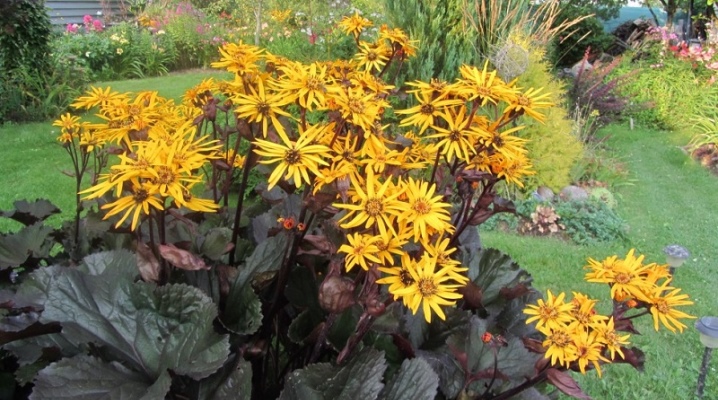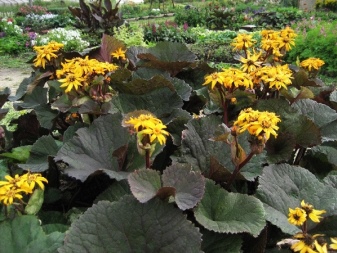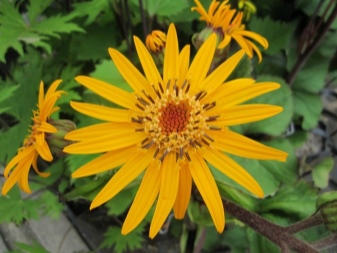Buzulnik toothed "Othello": description, planting and care

Buzulnik appeared many years ago in southwestern China, where it grew for a long time in the wild. However, the attractive appearance did its job - and already in the 20th century, experts drew attention to it, starting fruitful breeding work. After that, every year more and more new varieties were bred, one of which can be called the toothed buzulnik "Othello". It has its own differences, for example, the peculiar structure of the leaf plate and unusual beautiful flowers. How to plant this plant, how to care for the crop, we will consider in the article.

Description
Gardeners consider the toothed buzulnik a very beautiful and interesting plant, so they often choose it for planting in their plots. The "Othello" variety has spectacular leaves, bright flowers, and is also able to delight garden owners for a long time, since its flowering period is quite long.
This plant got its name due to the unusual structure of the leaf plate. Some believe that it resembles a deer's antlers. One cannot fail to note the original coloring: at the very beginning of summer it is dark purple, a little later, green tones appear on the front side, and the inner one turns purple with rich red veins, which can be compared with the vascular system.


As for flowering, for toothed buzulnika inflorescences resembling brushes are characteristic. The buds open in August and only bloom in October. In appearance, they resemble fiery orange chamomiles, each about 12 centimeters in diameter.
This variety can eventually reach a height of 1 meter. Buzulnik is notable for its frost resistance, however, the extreme drops in temperature characteristic of some regions of our country may not be able to withstand, therefore, in some cases, it requires protection.
If the areas are characterized by a harsh climate, you should think about shelter for the winter.


Comparison with the variety "Desdemona"
Along with the "Othello" variety, the toothed buzulnik named "Desdemona" is very popular among gardeners. There are a number of differences between plants. First of all, one should dwell on the colors, and we are talking about both flowers and leaves. Othello has bright orange buds, and rich greens are distinguished by crimson and violet hues. The leaves of "Desdemona" are lighter, pale green, the inner surface has a lilac tint. The flowers are red-orange. Especially the differences between plants are striking in windy weather. Stirring leaves allow the bush to play in different shades, which looks very beautiful and unusual.


Landing rules
The buzulnik feels best in the shade. He does not like direct sunlight, this must be taken into account when planning a place for landing. In addition, you need to take into account the exactingness in relation to humidity. Gardeners recommend placing the plant along the walls or in the back of the flower beds. It will look good between trees too.
The composition of the soil needs a special buzulnik. An exceptionally well-moistened soil rich in nutrients is suitable for him. It is possible to plant a flower on heavy clay soil that has drainage problems. If the site is located in an area prone to temporary flooding, this will not be particularly difficult.For Othello to fully grow and develop, it does not require significant efforts, but a number of procedures will be necessary.


In addition to the location, factors such as the competent choice of planting material and the preparation of the beds are important for the toothed buzulnik. Gardeners recommend buying seeds or seedlings at specialized points. You can go to both the retail store and the nursery. If we are talking about a seedling, it is necessary to evaluate its appearance in order to exclude the possibility of damage and any diseases. The integrity of the root system should also be monitored - any violations in it can become critical for the bush.
Before planting a flower, you should prepare the beds. This is done just before landing. The soil is carefully dug to the depth of the shovel bayonet.


Planting is done in the spring, before the buzulnik dissolves the leaves. The size of the landing pits should be 40x40 centimeters, and the distance between them should be from one to one and a half meters. When placed in the hole, the root system of the seedlings is neatly straightened, and from above it is filled with soil mixture prepared in advance. In addition to garden soil, humus and wood ash, as well as superphosphate, are added to it.
The buds should be above the ground. After planting, the plant is thoroughly watered.
With proper care, the buzulnik will begin to bloom already in the same season.



Care features
As already noted, toothed buzulnik is a rather unpretentious plant. However, full development and active flowering will be achieved only if at least a little attention is paid to it. Watering, feeding, loosening, pruning and garter are important points. Let's talk about these events in more detail.
As for watering, you need to remember that the buzulnik is a moisture-loving plant. It will need to be watered often and abundantly. It is considered ideal if the soil is constantly wet. If the weather is mild and warm, you can limit yourself to 1-2 procedures per week. In the case when the summer is hot and dry, you need to constantly check that the topsoil does not have time to dry out.
In addition, spraying will be useful in the morning and evening.

Nutrient soil will always be beneficial to the plant. Therefore, fertilization will also be required. The first time this is done when planting, when humus, superphosphate and wood ash are mixed with the ground. After that, there will be enough spring dressings, for which a mullein solution is quite suitable. If there is a need for nutrients before the onset of cold weather, humus can also be added after flowering.
The loosening procedure should become permanent. This will facilitate the access of oxygen to the root system. Dry peat mulching can be a great alternative. In addition, mulch will help to retain moisture, which is also very beneficial.
If the grower does not need seed, pruning can be done to help rejuvenate the shrub. In addition, it helps to maintain decorative qualities. During the formation of the bush, dead inflorescences are removed.


If the buzulnik has grown too large, rather large buds can bend it to the ground. To prevent this from happening, it is recommended to think about the support.
It must be said that the plant is resistant to many diseases and pest attacks. However, in the spring it can be overcome by slugs. To prevent insect infestation, sprinkle the bush with superphosphate granules.
If you follow agricultural techniques, flowers will delight gardeners for a long time.
The main thing is to take care of timely watering and quality nutrition.


Use in landscape design
Landscape designers agree that the scalloped buzulnik "Othello" looks very advantageous in group plantings. In addition to an attractive appearance, this placement allows you to hide aging tree crowns.The color-changing foliage will create new images, and the inflorescences will delight you with a riot and brightness of colors.


The plant looks and feels best in shaded areas or along the banks of water bodies. A combination with near-water plants, for example, marsh irises, will be effective. You can plant flowers alone.


Planting in the same group of different varieties of buzulnik is not prohibited. They will look very interesting as they have different colors, heights and shapes.


You can learn how to plant Othello toothed buzulnik by watching the video below.







































































































The comment was sent successfully.